Microsoft Entra SSO integration with JIRA SAML SSO by Microsoft
In this article, you'll learn how to integrate JIRA SAML SSO by Microsoft with Microsoft Entra ID. When you integrate JIRA SAML SSO by Microsoft with Microsoft Entra ID, you can:
- Control in Microsoft Entra ID who has access to JIRA SAML SSO by Microsoft.
- Enable your users to be automatically signed-in to JIRA SAML SSO by Microsoft with their Microsoft Entra accounts.
- Manage your accounts in one central location.
Description
Use your Microsoft Entra account with Atlassian JIRA server to enable single sign-on. This way all your organization users can use the Microsoft Entra credentials to sign in into the JIRA application. This plugin uses SAML 2.0 for federation.
Prerequisites
To configure Microsoft Entra integration with JIRA SAML SSO by Microsoft, you need the following items:
- A Microsoft Entra subscription. If you don't have a subscription, you can get a free account.
- JIRA Core and Software 7.0 to 9.17.4 or JIRA Service Desk 3.0 to 4.22.1 should be installed and configured on Windows 64-bit version.
- JIRA server is HTTPS enabled.
- Note the supported versions for JIRA Plugin are mentioned in below section.
- JIRA server is reachable on the Internet particularly to the Microsoft Entra login page for authentication and should able to receive the token from Microsoft Entra ID.
- Admin credentials are set up in JIRA.
- WebSudo is disabled in JIRA.
- Test user created in the JIRA server application.
Note
To test the steps in this article, we do not recommend using a production environment of JIRA. Test the integration first in development or staging environment of the application and then use the production environment.
To get started, you need the following items:
- Do not use your production environment, unless it is necessary.
- JIRA SAML SSO by Microsoft single sign-on (SSO) enabled subscription.
Note
This integration is also available to use from Microsoft Entra US Government Cloud environment. You can find this application in the Microsoft Entra US Government Cloud Application Gallery and configure it in the same way as you do from public cloud.
Supported versions of JIRA
- JIRA Core and Software: 7.0 to 9.17.4.
- JIRA Service Desk 3.0 to 4.22.1.
- JIRA also supports 5.2. For more details, click Microsoft Entra single sign-on for JIRA 5.2.
Note
Please note that our JIRA Plugin also works on Ubuntu Version 16.04 and Linux.
Microsoft SSO plugins
Microsoft Entra ID single sign-on for JIRA datacenter application
Microsoft Entra ID single sign-on for JIRA server-side application
Scenario description
In this article, you configure and test Microsoft Entra SSO in a test environment.
- JIRA SAML SSO by Microsoft supports SP initiated SSO.
Adding JIRA SAML SSO by Microsoft from the gallery
To configure the integration of JIRA SAML SSO by Microsoft into Microsoft Entra ID, you need to add JIRA SAML SSO by Microsoft from the gallery to your list of managed SaaS apps.
- Sign in to the Microsoft Entra admin center as at least a Cloud Application Administrator.
- Browse to Identity > Applications > Enterprise applications > New application.
- In the Add from the gallery section, type JIRA SAML SSO by Microsoft in the search box.
- Select JIRA SAML SSO by Microsoft from results panel and then add the app. Wait a few seconds while the app is added to your tenant.
Alternatively, you can also use the Enterprise App Configuration Wizard. In this wizard, you can add an application to your tenant, add users/groups to the app, assign roles, as well as walk through the SSO configuration as well. Learn more about Microsoft 365 wizards.
Configure and test Microsoft Entra SSO for JIRA SAML SSO by Microsoft
Configure and test Microsoft Entra SSO with JIRA SAML SSO by Microsoft using a test user called B.Simon. For SSO to work, you need to establish a link relationship between a Microsoft Entra user and the related user in JIRA SAML SSO by Microsoft.
To configure and test Microsoft Entra SSO with JIRA SAML SSO by Microsoft, perform the following steps:
- Configure Microsoft Entra SSO - to enable your users to use this feature.
- Create a Microsoft Entra test user - to test Microsoft Entra single sign-on with B.Simon.
- Assign the Microsoft Entra test user - to enable B.Simon to use Microsoft Entra single sign-on.
- Configure JIRA SAML SSO by Microsoft SSO - to configure the single sign-on settings on application side.
- Create JIRA SAML SSO by Microsoft test user - to have a counterpart of B.Simon in JIRA SAML SSO by Microsoft that is linked to the Microsoft Entra representation of user.
- Test SSO - to verify whether the configuration works.
Configure Microsoft Entra SSO
Follow these steps to enable Microsoft Entra SSO.
Sign in to the Microsoft Entra admin center as at least a Cloud Application Administrator.
Browse to Identity > Applications > Enterprise applications > JIRA SAML SSO by Microsoft > Single sign-on.
On the Select a single sign-on method page, select SAML.
On the Set up single sign-on with SAML page, click the pencil icon for Basic SAML Configuration to edit the settings.

On the Basic SAML Configuration section, perform the following steps:
a. In the Identifier box, type a URL using the following pattern:
https://<domain:port>/b. In the Reply URL text box, type a URL using the following pattern:
https://<domain:port>/plugins/servlet/saml/autha. In the Sign-on URL text box, type a URL using the following pattern:
https://<domain:port>/plugins/servlet/saml/authNote
These values are not real. Update these values with the actual Identifier, Reply URL, and Sign-on URL. Port is optional in case it’s a named URL. These values are received during the configuration of Jira plugin, which is explained later in the article.
On the Set up single sign-on with SAML page, In the SAML Signing Certificate section, click copy button to copy App Federation Metadata Url and save it on your computer.

The Name ID attribute in Microsoft Entra ID can be mapped to any desired user attribute by editing the Attributes & Claims section.

a. After clicking on Edit, any desired user attribute can be mapped by clicking on Unique User Identifier (Name ID).
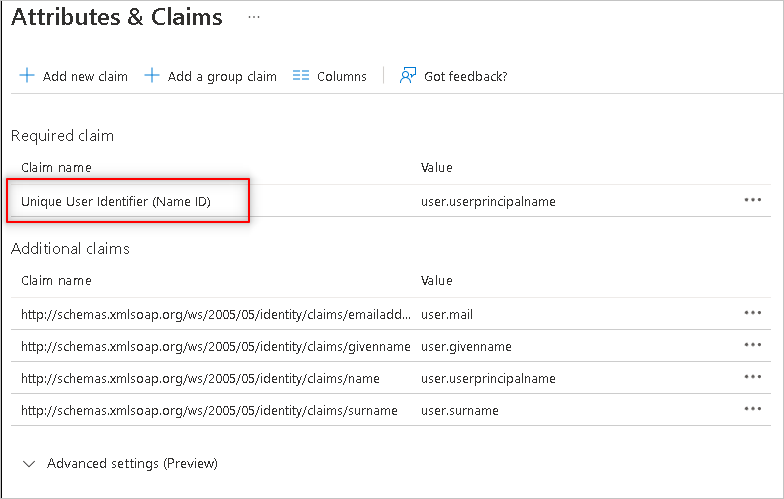
b. On the next screen, the desired attribute name like user.userprincipalname can be selected as an option from the Source Attribute dropdown menu.
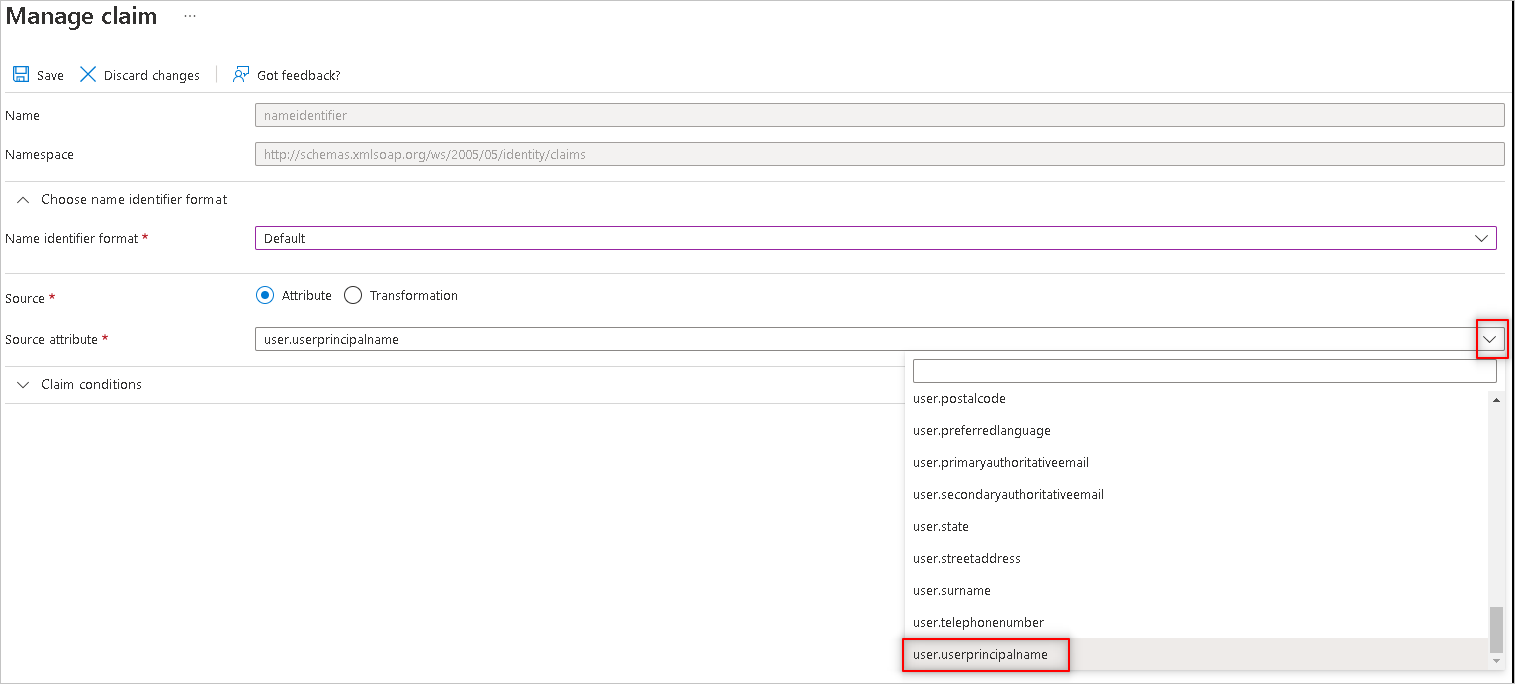
c. The selection can then be saved by clicking on the Save button at the top.
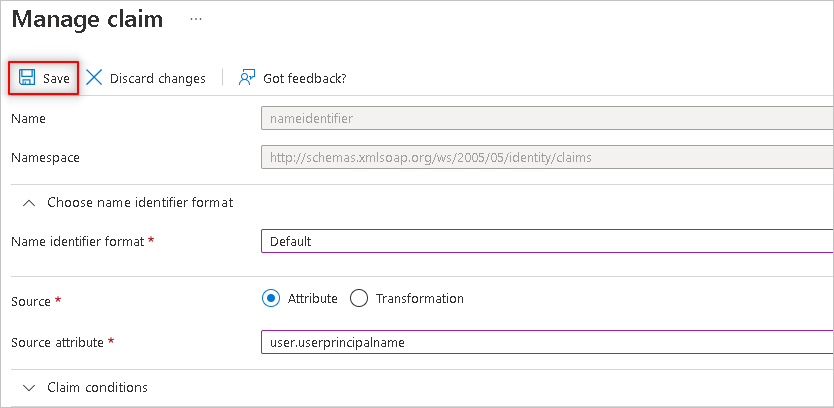
d. Now, the user.userprincipalname attribute source in Microsoft Entra ID is mapped to the Name ID attribute name in Microsoft Entra which will be compared with the username attribute in Atlassian by the SSO plugin.
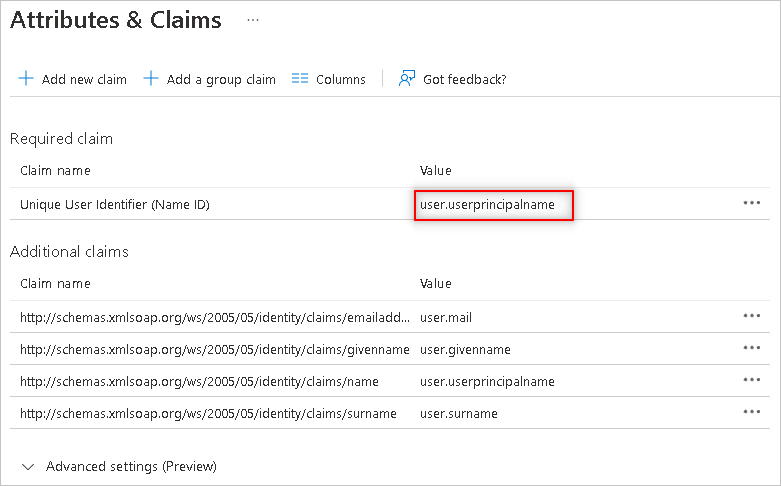
Note
The SSO service provided by Microsoft Azure supports SAML authentication which is able to perform user identification using different attributes such as givenname (first name), surname (last name), email (email address), and user principal name (username). We recommend not to use email as an authentication attribute as email addresses are not always verified by Microsoft Entra ID. The plugin compares the values of Atlassian username attribute with the NameID attribute in Microsoft Entra ID in order to determine the valid user authentication.
If your Azure tenant has guest users then follow the below configuration steps:
a. Click on pencil icon to go to the Attributes & Claims section.

b. Click on NameID on Attributes & Claims section.

c. Setup the claim conditions based on the User Type.
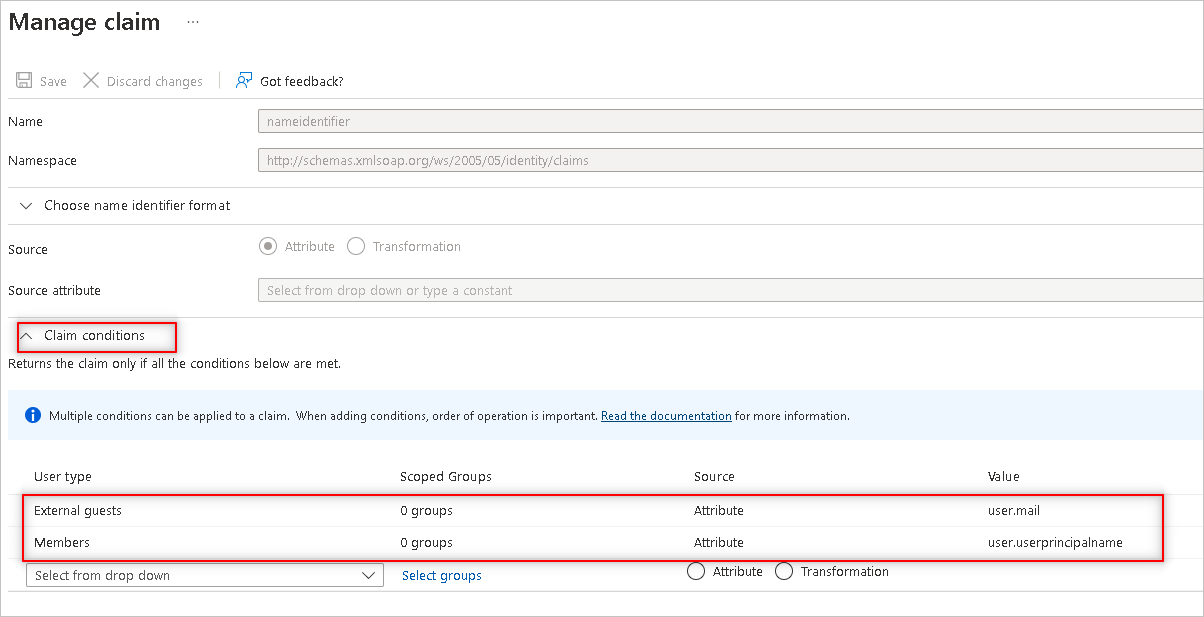
Note
Give the NameID value as
user.userprinciplenamefor Members anduser.mailfor External Guests.d. Save the changes and verify the SSO for external guest users.
Create a Microsoft Entra test user
In this section, you'll create a test user called B.Simon.
- Sign in to the Microsoft Entra admin center as at least a User Administrator.
- Browse to Identity > Users > All users.
- Select New user > Create new user, at the top of the screen.
- In the User properties, follow these steps:
- In the Display name field, enter
B.Simon. - In the User principal name field, enter the username@companydomain.extension. For example,
B.Simon@contoso.com. - Select the Show password check box, and then write down the value that's displayed in the Password box.
- Select Review + create.
- In the Display name field, enter
- Select Create.
Assign the Microsoft Entra test user
In this section, you'll enable B.Simon to use single sign-on by granting access to JIRA SAML SSO by Microsoft.
- Sign in to the Microsoft Entra admin center as at least a Cloud Application Administrator.
- Browse to Identity > Applications > Enterprise applications > JIRA SAML SSO by Microsoft.
- In the app's overview page, select Users and groups.
- Select Add user/group, then select Users and groups in the Add Assignment dialog.
- In the Users and groups dialog, select B.Simon from the Users list, then click the Select button at the bottom of the screen.
- If you are expecting a role to be assigned to the users, you can select it from the Select a role dropdown. If no role has been set up for this app, you see "Default Access" role selected.
- In the Add Assignment dialog, click the Assign button.
Configure JIRA SAML SSO by Microsoft SSO
In a different web browser window, sign in to your JIRA instance as an administrator.
Hover on cog and click the Add-ons.

Download the plugin from Microsoft Download Center. Manually upload the plugin provided by Microsoft using Upload add-on menu. The download of plugin is covered under Microsoft Service Agreement.

For running the JIRA reverse proxy scenario or load balancer scenario perform the following steps:
Note
You should be configuring the server first with the below instructions and then install the plugin.
a. Add below attribute in connector port in server.xml file of JIRA server application.
scheme="https" proxyName="<subdomain.domain.com>" proxyPort="<proxy_port>" secure="true"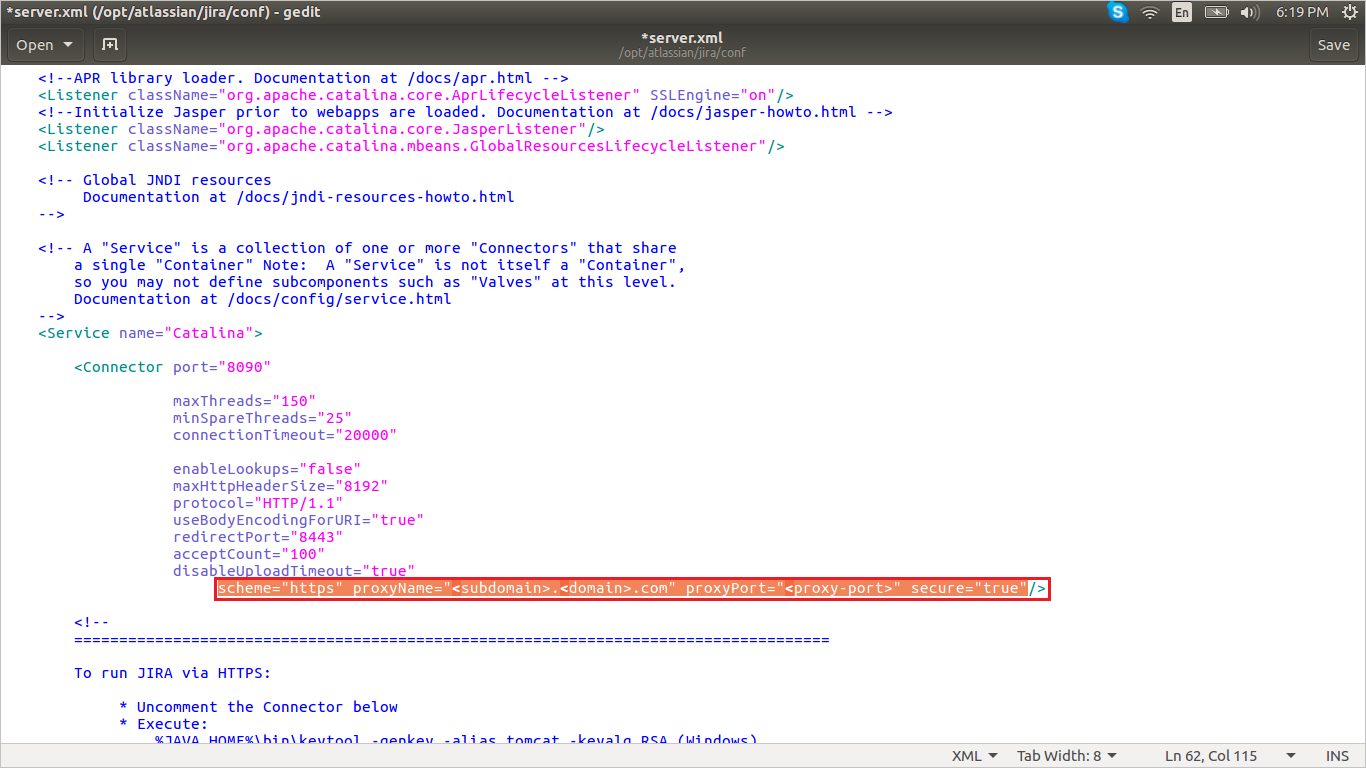
b. Change Base URL in System Settings according to proxy/load balancer.
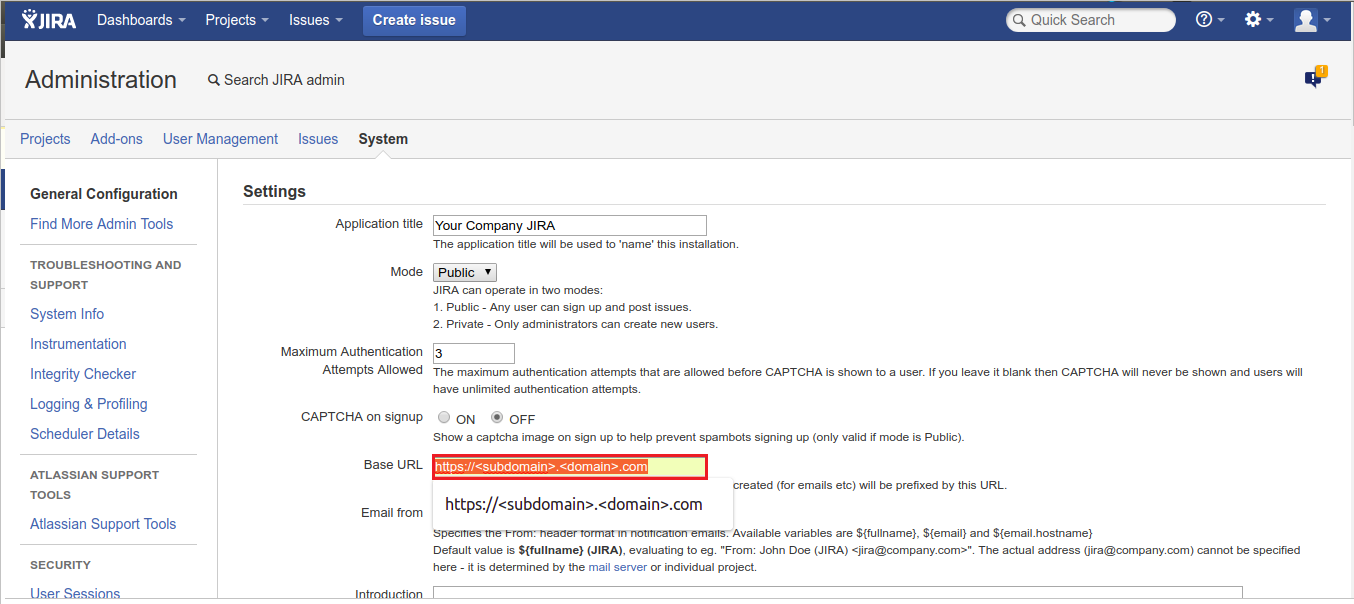
Once the plugin is installed, it appears in User Installed add-ons section of Manage Add-on section. Click Configure to configure the new plugin.
Perform following steps on configuration page:

Tip
Ensure that there is only one certificate mapped against the app so that there is no error in resolving the metadata. If there are multiple certificates, upon resolving the metadata, admin gets an error.
a. In the Metadata URL textbox, paste App Federation Metadata Url value which you have copied and click the Resolve button. It reads the IdP metadata URL and populates all the fields information.
b. Copy the Identifier, Reply URL and Sign on URL values and paste them in Identifier, Reply URL and Sign on URL textboxes respectively in JIRA SAML SSO by Microsoft Domain and URLs section on Azure portal.
c. In Login Button Name type the name of button your organization wants the users to see on login screen.
d. In Login Button Description type the description of button your organization wants the users to see on login screen.
e. In Default Group, select your organization default group to assign to new users. Default groups facilitate organized access rights to new user accounts.
f. In SAML User ID Locations select either User ID is in the NameIdentifier element of the Subject statement or User ID is in an Attribute element. This ID has to be the JIRA user ID. If the user ID is not matched, then the system doesn't allow users to sign in.
Note
Default SAML User ID location is Name Identifier. You can change this to an attribute option and enter the appropriate attribute name.
g. If you select User ID is in an Attribute element, then for Attribute name, type the name of the attribute where the user ID is expected.
h. In Auto-create User feature (JIT User Provisioning): It automates user account creation in authorized web applications, without the need for manual provisioning. This reduces administrative workload and increases productivity. Because JIT relies on the login response from Azure AD, enter the SAML-response attribute values, which include the user's email address, last name, and first name.
i. If you are using the federated domain (like ADFS, and so on) with Microsoft Entra ID, then click on the Enable Home Realm Discovery option and configure the Domain Name.
j. In Domain Name type the domain name here in case of the ADFS-based login.
k. Select Enable Single Sign out if you want to sign out of Microsoft Entra ID when a user signs out of JIRA.
l. Enable Force Azure Login if you want to sign in by using only Microsoft Entra ID credentials.
Note
To enable the default login form for admin login on login page when force azure login is enabled, add the query parameter in the browser URL.
https://<domain:port>/login.jsp?force_azure_login=falsem. Select Enable Use of Application Proxy if you configured your on-premises Atlassian application in an application proxy setup.
- For App proxy setup , follow the steps on the Microsoft Entra application proxy Documentation.
n. Select Save to save the settings.
Note
For more information about installation and troubleshooting, visit MS JIRA SSO Connector Admin Guide. There is also an FAQ for your assistance.
Create JIRA SAML SSO by Microsoft test user
To enable Microsoft Entra users to sign in to JIRA on-premises server, they must be provisioned into JIRA SAML SSO by Microsoft. For JIRA SAML SSO by Microsoft, provisioning is a manual task.
To provision a user account, perform the following steps:
Sign in to your JIRA on-premises server as an administrator.
Hover on cog and click the User management.
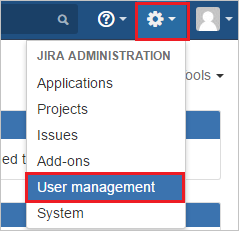
You are redirected to Administrator Access page to enter Password and click Confirm button.
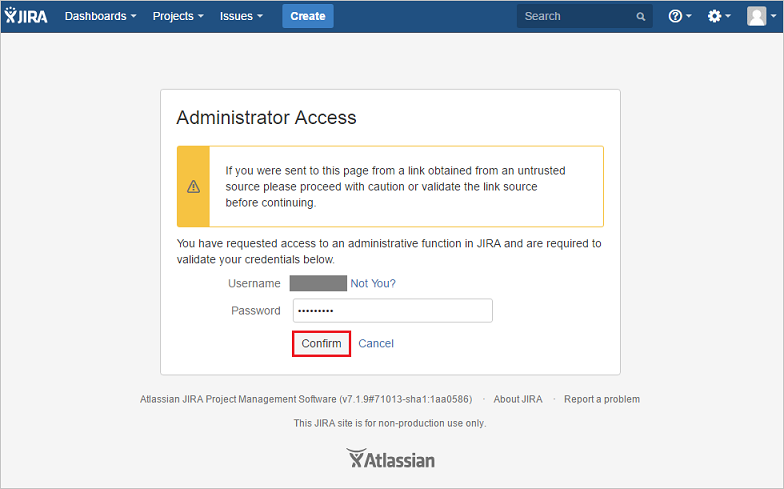
Under User management tab section, click create user.

On the “Create new user” dialog page, perform the following steps:
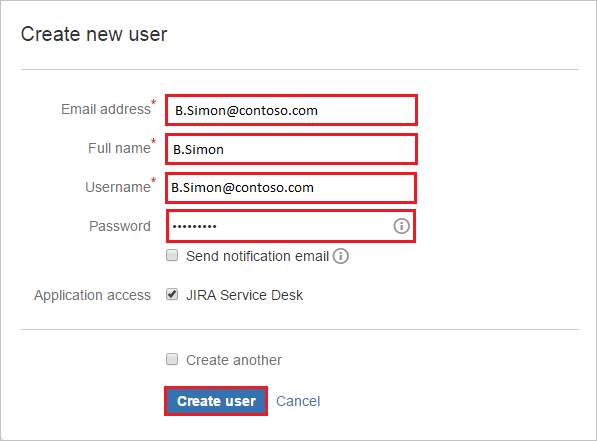
a. In the Email address textbox, type the email address of user like B.simon@contoso.com.
b. In the Full Name textbox, type full name of the user like B.Simon.
c. In the Username textbox, type the email of user like B.simon@contoso.com.
d. In the Password textbox, type the password of user.
e. Click Create user.
Test SSO
In this section, you test your Microsoft Entra single sign-on configuration with following options.
Click on Test this application, this will redirect to JIRA SAML SSO by Microsoft Sign-on URL where you can initiate the login flow.
Go to JIRA SAML SSO by Microsoft Sign-on URL directly and initiate the login flow from there.
You can use Microsoft My Apps. When you click the JIRA SAML SSO by Microsoft tile in the My Apps, this will redirect to JIRA SAML SSO by Microsoft Sign-on URL. For more information about the My Apps, see Introduction to the My Apps.
Related content
Once you configure JIRA SAML SSO by Microsoft you can enforce Session control, which protects exfiltration and infiltration of your organization’s sensitive data in real time. Session control extends from Conditional Access. Learn how to enforce session control with Microsoft Defender for Cloud Apps.